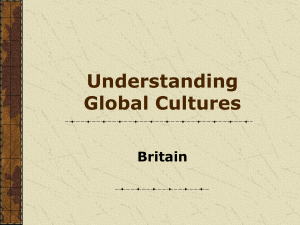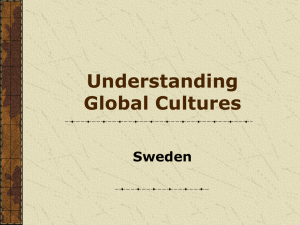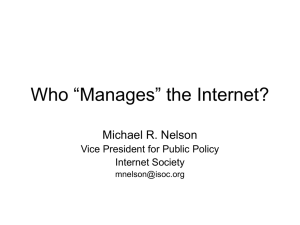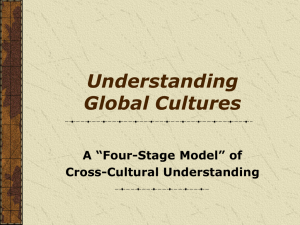U.S. Culture
advertisement
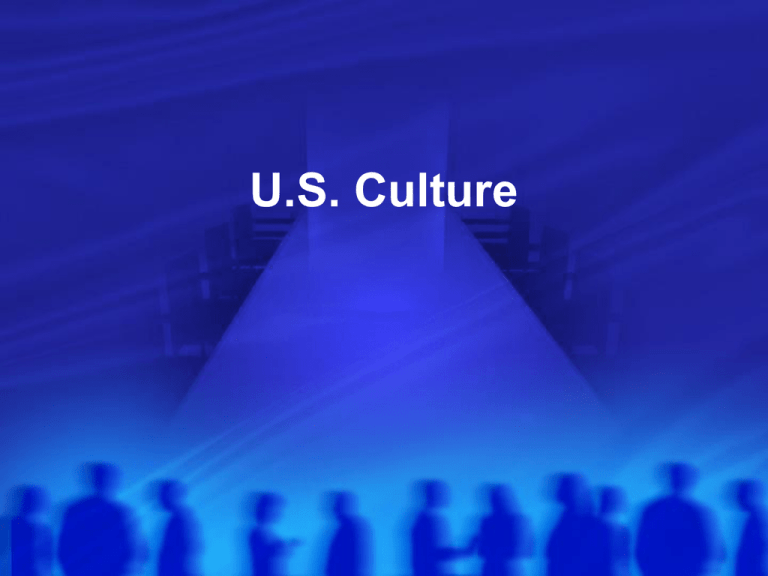
U.S. Culture List as many “American values” that you can think of Remember values are the standards by which people define good and bad, beautiful and ugly Basic Values According to sociologist Robin Williams, 15 basic values are dominant in US culture: Success Hard work Efficiency Material comfort Morality Humanitarianism Progress Democracy -Science -External conformity -Individualism -In-group superiority -Equality - Freedom - Patriotism Value Clusters Made up of related core values that come together to form a larger whole Example: Success We find hard work, education, efficiency, material comfort and individualism all bound together Value Contractions Some values conflict with each other Example: There cannot be full expressions of democracy, equality, racism and sexism at the same time As society changes some values are challenged and undergo modification Culture War Core values do not change without meeting strong resistance Today’s clash in values is so severe that it is referred to a culture war Values blind people Values and their supporting beliefs may blind people to other social circumstances Example: the emphasis on individualism So high that many people in the US believe that everyone is free to pursue the goal of success Blinds them to the consequences of family poverty, lack of education and dead-end jobs Ideal Culture v. Real Culture Ideal Culture- refers to the ideal values and norms of people Most people fall short of this Real Culture- norms and values that people actually follow Changing Society As society changes over time new values emerge that reflect changed social conditions For example: leisure, physical fitness, self-fulfillment, concern for environment Culture Changes is 3 ways Invention- creating new cultural elements Telephone, airplane, internet Discovery- Recognizing a better understanding of something already in existence X-Ray, DNA Diffusion- The spread of cultural traits from one society to another Jazz music, slang words, etc. technology Central to material culture is technology Refers to tool but can include the skills or procedures to make and use those tools New technologies refer to the emerging technologies that have a major impact on human life Culture Lag Term coined by William Ogburn Refers to a situation in which not all parts of a culture change at the same pace A group’s material culture usually changes first Non-material culture lags behind Sometimes non-material culture never catches up Cultural diffusion The transmission of cultural characteristics Material culture is more likely to change because of cultural diffusion One consequence: Cultural leveling The process in which cultures become similar to one another Example: Japan adopting western culture Culture Clash Differences among cultures can be expected to generate most of the conflict around the world Coming in contact with radically different cultures produces culture shock Challenging our basic assumptions about life Ethnocentrism The attitude that one’s own culture is superior to those of other people Can serve as the glue to hold society together Strong sense of unity as a nation Cultural Relativism The belief that a culture must be understood on its own terms Looking at a culture from their own perspective and understand why they do things their way Can contribute to international peace Multicultural US is made up of different cultures I.e. Anglo, Hispanic, African Multiculturalism- a state in which all subcultures in the same society are equal to one another Varies in degree from 1 society to another Switzerland most multicultural (Fr, Gm, It) Bosnia- minorities are despised and often killed US somewhere in between US Multiculturalism Eurocentrism- view the world from the standpoint of European culture Afrocentrism- the view of world from the standpoint of African culture Pop Culture Popular culture consists of relatively unsophisticated artistic creations that appeal to the mass audience Movies, tv shows, music Cultural Universals All human beings have the same needs that must be met in order to survive Biological needs- food and shelter Social needs- clothing, complex communication, peaceful coexistence, aesthetic spiritual experiences These needs are universal Cultural Universals- practices found in all cultures as the means for meeting the same human needs Food gathering Building houses Developing language - art forms - religion What values do celebrities portray?







